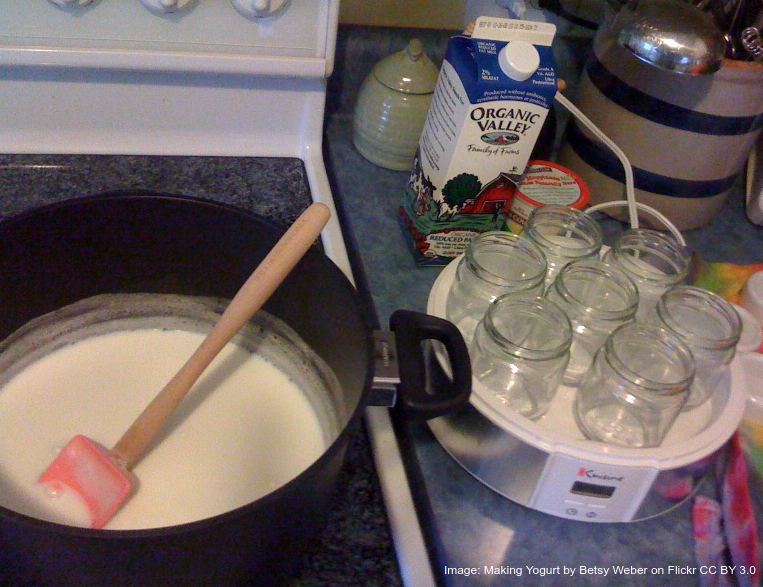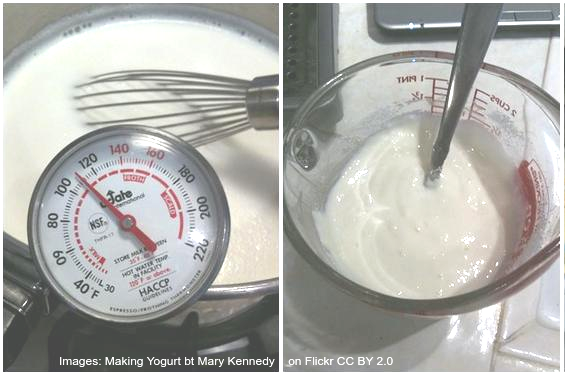Inquiry into milk turning to yoghurt.
 This lab is an introduction to the identification of controlled variables in the exploration section of an investigation. Good training for the IA. Students consider the chemical composition of milk, the affect of heating milk proteins and role of lactic acid bacteria in changing the pH of milk transforming it into yoghurt. A method of estimating the number and types of bacteria found in milk and yoghurt is used to carry out a simple comparison of milk, yoghurt and kefir. This lab could be used as a 'mini IA' to introduce students to one or more aspects of the Individual assessment, such as sample size or hypothesis testing.
This lab is an introduction to the identification of controlled variables in the exploration section of an investigation. Good training for the IA. Students consider the chemical composition of milk, the affect of heating milk proteins and role of lactic acid bacteria in changing the pH of milk transforming it into yoghurt. A method of estimating the number and types of bacteria found in milk and yoghurt is used to carry out a simple comparison of milk, yoghurt and kefir. This lab could be used as a 'mini IA' to introduce students to one or more aspects of the Individual assessment, such as sample size or hypothesis testing.
Lesson Description
 Guiding Questions
Guiding Questions
Outline the properties of your favourite yoghurt.
What happens inside the milk as yoghurt is being formed?
Activity 1 - Brainstorm questions about the formation of yoghurt.
There are several changes taking place in milk proteins during the heating of milk and the lowering of pH which takes place as lactic acid bacteria ferment the milk. The composition of the milk also contributes to the rate of change. As bacteria populations grow in the milk and change it's chemical composition they produce yoghurt.
To Do
Consider the information in the slides below and
Think of as many questions as you can which it would be interesting to know more about.
Write a list of these questions, to use in Activity 2 ![]() Prioritising questions about yoghurt.
Prioritising questions about yoghurt.
Example of questions:
Does the yoghurt set faster if it is made with full fat milk?
Which type starter changes the pH of the milk fastest?
How much heating of the milk is needed to make the best setting yoghurt
Further reading:
This short interesting paper by Siewerts (2016) Microbial interactions in yoghurt describes evidence supporting the idea that two species of lactic acid bacteria gain mutual benefit from each other when fermenting yoghurt.
A thorough introduction to bacteria in dairy processing can be found in The Dairy Science and Technology eBook from the University of Guelph. It contains information about many factors which can affect the growth of lactic acid bacteria and also some methods of estimating bacteria populations.
Activity 2 - Asking the right questions
Complete the activity using the worksheet ![]() Prioritising questions about yoghurt.
Prioritising questions about yoghurt.
This could be preparation for Activity 3 Gram staining bacteria in yoghurt.
To do
Identify the open and closed questions from the list of questions in Activity 1
Change some of the closed questions into open questions.
Select the three most interesting questions.
Identify a cause (independent variable) and an effect (dependent variable) in each of these questions.
Scan through the whole list of questions to try and find other factors which may cause a change in the yoghurt making.
Complete the final sections on the worksheet of research question ideas and controlled variable ideas.
Activity 3 - Mini IA 'Analysis of the effect of adding sugar to yoghurt before fermentation'
In completing Activity 2 to prioritise questions a student decided on an IA research question. They wanted to try to find out if there are the same numbers of Lactobacillus and Lactococcus bacteria in yoghurt made when a little sugar is added, compared to yoghurt made without adding sugar.
During the questions activity many variables were identified which needed controlling. See the table below for five examples.
Variables which affect the process (They will need to be controlled in an investigation). | What would happen if this variable increased / decreased during an experiment? |
|---|---|
The temperature of the heat treatment of the milk | If this temperature was lower in one of the experiments then some of the bacteria in the milk might survive and compete with the lactic acid bacteria. |
The type of milk | The composition of nutrients, proteins and lipids as well as lactose sugars would be different in different types of milk and this could increase or decrease the growth of specific bacteria species. |
The type of starter culture added | Obviously if there were more bacteria added to one experiment then there would probably be more bacteria growing in this yoghurt. |
The length of time the yoghurt fermentation is given | The longer the culture is left fermenting the more time there is for the bacteria to grow. So there would be more bacteria if the culture has more time. |
The temperature of the fermentation process. | Bacteria may grow more rapidly in warmer temperatures. |
The student wrote the following procedure to test the research question.
Follow this method to make some yoghurt with and without adding sugar and then to sample the yoghurt, Gram stain any bacteria. ![]() Investigating Yoghurt - does adding sugar help? (This may have been done before the lesson to save time).
Investigating Yoghurt - does adding sugar help? (This may have been done before the lesson to save time).
Evaluate the theory that there will be more bacteria in the yoghurt made when adding sugar, by making two microscope slides with the Grams staining technique and counting bacteria found in five different eyepiece views of each sample at a magnification of x400.
Teacher's notes
In recent years there have been frequent comments in the DP Biology Examiner's reports about use of microorganisms.
The guidance now states clearly that in IA's students should only culture known non-pathogenic strains of bacteria, and advises that students should not swab door handles or hands.
This protocol using yoghurt bacteria can be said to use 'known non-pathogenic strains', yoghurt bought for human consumption has been tested during production. This greatly reduces the risk of culturing pathogenic bacteria, however this does not eliminate it completely, so the usual strict rules of hygiene and aseptic technique should be used.
This video is a nice explanation of serial dilution and CFUs https://www.youtube.com/watch?v=zA_jygdC1Yk&list=PLL0D4plWid-tT4OstYDlfALbNQqDSr-KK&index=10
Gram staining yoghurt experiment: http://www.schoolscience.co.uk/documentdownload.axd?documentresourceid=164
Yoghurt lab protocol: https://mymission.lamission.edu/userdata/brownst/docs/Yogurt%20Preparation%20Lab.pdf
A great simple method to view yoghurt bacteria from Microscope.com. microbe lab
https://www.microscope.com/bacterial-succession-in-milk/
Note: there are lots of youtube videos too.
Simple yoghurt bacteria and description of shape
https://www2.mrc-lmb.cam.ac.uk/microscopes4schools/yoghurt.php

 IB Docs (2) Team
IB Docs (2) Team
